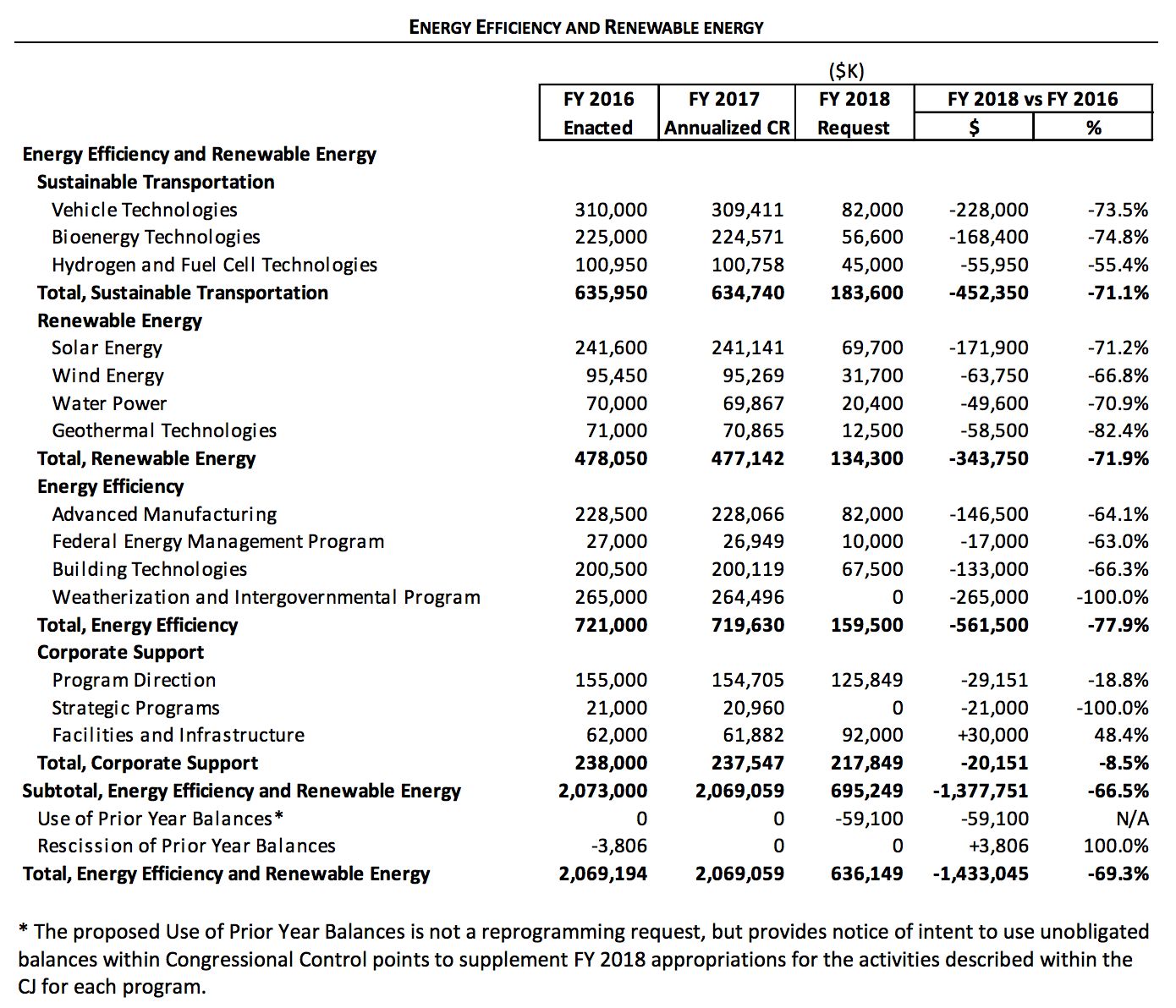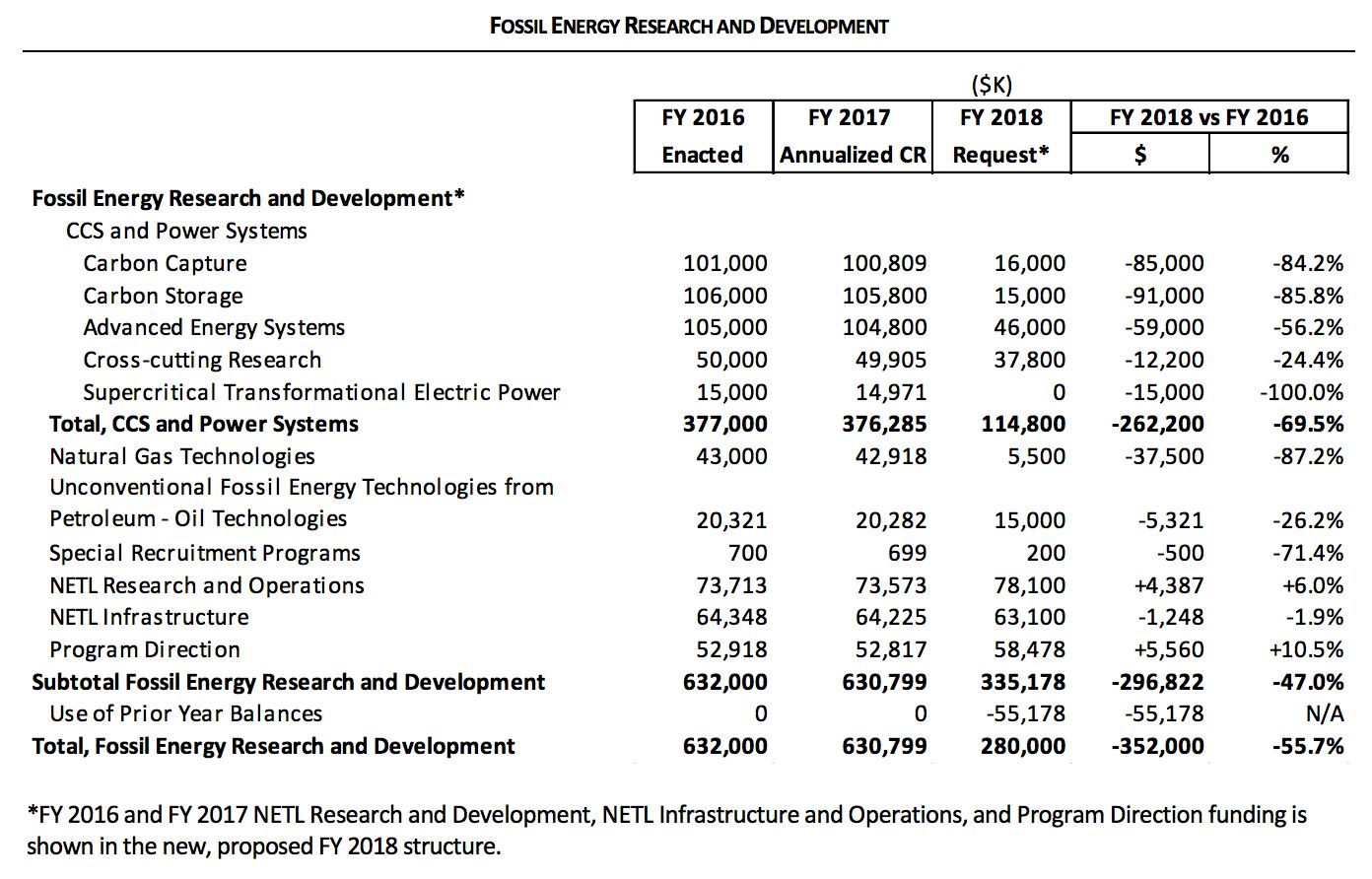The Trump administration presented a $4.1 trillion budget for fiscal year 2018 today, which includes $3.6 trillion in spending cuts over the next 10 years in an attempt to balance the budget by 2027. In addition to deep cuts for health care, student loans and food stamps, the White House has proposed to slash budgets for climate and clean energy programs -- despite the bipartisan support many of these initiatives enjoy.
If approved, the Environmental Protection Agency would see the steepest cuts of any agency, with a 31.4 percent budget trim that would shutter 50 agency programs and do away with 3,200 of the agency’s 15,000 jobs. The White House also proposed to zero out funding for ENERGY STAR, as well as several popular Department of Energy programs, including the Advanced Research Projects Agency for Energy (ARPA-E).
Trump's request comes as no surprise. The administration has said repeatedly that it is intent on rebooting traditional manufacturing and fossil fuel industries, and plans to de-emphasize or eliminate environmental programs. While Congress will ultimately decide U.S. funding levels, the president’s budget request gives insight into how at least some members of the Republican party are thinking about the role of the government and which programs may continue to be at risk.
Here is a rundown of what’s on the chopping block in the clean energy arena.
Department of Energy
Overall, the Department of Energy would see a relatively minor 5.3 percent or $1.6 billion cut under President Trump’s proposal, compared to 2016 funding levels (note: all funding amounts in this section reflect the proposed cuts compared to 2016 funding levels). A significant portion of those cuts would affect the agency's clean energy programs, however. The budget summary shows continued support for research and development programs, but the emphasis has shifted to early-stage technologies and strengthening U.S. nuclear weapons capabilities. With this shift, the DOE’s fossil fuel programs would also see their budgets shrink. Here is the breakdown.
Office of Energy Efficiency and Renewable Energy: The DOE's efficiency and renewables office would see a 70 percent or $1.4 billion budget cut under the president’s proposal. This includes a 74 percent cut to EERE’s solar, wind, water and geothermal programs and a 73.5 percent cut to the vehicle technologies program.
Despite lower funding levels, the DOE budget overview makes reference to ongoing support for "cutting-edge innovation," which appears to include clean energy solutions. For instance, the summary states that the vehicle technologies program will continue to “explore new battery chemistry and cell technologies with the potential to reduce the cost of electric vehicle batteries by more than half to less than $100/kWh (ultimate goal is $80/kWh), increase range to 300 miles, and decrease charge time to 15 minutes or less.”
The Advanced Manufacturing Office, which is intended to help develop emerging technologies and create U.S. manufacturing jobs, would see a 64 percent budget drop under Trump's plan. “The Budget for AMO reasserts the proper role of the Federal Government by reflecting an increased reliance on the private sector to fund later-stage research, development, and commercialization of energy technologies and focusing funding toward early-stage R&D,” the budget states.
The Building Technologies Office, first implemented under President Ronald Reagan, would see a major funding cut too. This office works to improve efficiency capabilities in homes and buildings, including the development of appliance and equipment efficiency standards that save the average household nearly $500 per year in reduced energy bills, according to the Alliance to Save Energy. BTO also does the technical work necessary to help states and local governments develop improved efficiency codes for homes and buildings, which can save homeowners $5,000 to $25,000 over the life of their mortgage, depending on the region.

Office of Electricity Delivery and Energy Reliability: This office, which works to ensure the U.S. energy delivery system is secure, resilient and reliable, would see a 42 percent budget reduction under Trump's plan. This includes cuts to smart grid, cybersecurity and energy storage programs.

Office of Nuclear Energy: While Energy Secretary Rick Perry has emphasized the importance of baseload energy resources, the Office of Nuclear Energy -- which has the primary mission of advancing nuclear power -- would see a 29 percent budget cut under Trump’s proposal. Meanwhile, the DOE’s weapons-related nuclear programs could see an 11.2 percent increase. Other environmental and atomic energy defense programs would see a 5.2 percent and a 9.3 percent budget increase, respectively.
Fossil Energy Programs: The DOE’s fossil fuel programs were not exempt from the budget trim, either. Overall, these programs would see a 45 percent cut, with significant reductions in fossil energy research and development. For instance, despite touting the promise of “clean coal” during a presidential debate, Trump’s 2018 budget virtually eliminates DOE spending on carbon capture and carbon storage.

The following DOE programs, from various offices, would be fully eliminated under the president’s proposal.
Weatherization Assistance Program: WAP offers grant-based assistance to low-income families to improve the energy efficiency of their homes. In a typical year, WAP delivers $340 million in energy savings, supports 8,500 jobs, and has a program-wide benefit-cost ratio of 4:1, according to the Alliance to Save Energy.
State Energy Program: SEP provides states with financial resources, technical assistance, technology deployment, strategic partnerships and other resources, with the aim of increasing energy efficiency, reducing energy costs, improving the reliability of energy services, developing alternative energy resources, promoting economic growth and decreasing oil imports. The Alliance to Save Energy fact sheet states: For every $1 of investment the federal government provides to the SEP, $7.23 is saved from reduced energy bills, while every $50 million in SEP funding results in $585 million in economic development.
Advanced Technology Vehicle Manufacturing Loan Program and Title 17 Innovative Technology Loan Guarantee Program: The Trump administration proposes to eliminate these programs “because the private sector is better positioned to finance innovative technologies.” Meanwhile, the Loan Programs Office would continue to conduct monitoring of existing loans.
Advanced Research Projects Agency for Energy: The ARPA-E program enjoys strong support from both political parties. The budget request states that the program “catalyzes transformational energy technologies to enhance the economic, environmental, and energy security of the United States.” Nonetheless, the Trump administration has proposed to eliminate the program “with operations winding down in 2018 and the office shutting down in FY 2019, at which point remaining monitoring and contract closeout activities would be transferred elsewhere within DOE.” For background, ARPA-E announced about $95 million in federal funding for 22 projects in 2014, which went on to raise more than $625 million in private-sector investment, not including two major projects that went public.
Environmental Protection Agency
President Trump’s budget eliminates 30 percent of the EPA’s funding, setting the budget at $5.65 billion -- $2.6 billion less than the Fiscal Year 2017 Continuing Resolution funding level. The proposal would shutter 50 EPA programs and eliminate 3,200 of the agency’s 15,000 jobs. Some of the notable cuts under the proposed budget plan include:
- Science and Technology Programs: Reduced from $733 million in FY 2017 to $450 million
- Federal Vehicle and Fuels Standards and Certification: Reduced from $93 million in FY 2017 to $76 million
- Air and Energy Research: 67 percent cut, reduced from $91.7 million in FY 2017 to around $30 million
The following EPA programs would be eliminated under the president’s proposal, among the 50 programs eliminated in total.
The Greenhouse Gas Reporting Program: The FY 2018 budget zeroes out the Greenhouse Gas Reporting Program, which is used to track carbon dioxide and other emissions linked to climate change. The EPA budget overview states that 15 sub-program projects would also be eliminated “as part of the Administration’s commitment to return EPA to its core work.” Those programs include:
- AgSTAR
- Center for Corporate Climate Leadership
- Coalbed Methane Outreach Program
- Combined Heat & Power Partnership
- ENERGY STAR
- Global Methane Initiative
- GreenChill Partnership
- Green Power Partnership
- Landfill Methane Outreach Program
- Natural Gas STAR
- Responsible Appliance Disposal Program
- SF6 Reduction Partnership for Electric Power Systems
- SmartWay
- State and Local Climate Energy Program
- Voluntary Aluminum Industrial Partnership
ENERGY STAR, created in 1992 under President George H. W. Bush, costs about $50 million to administer yet delivered $34 billion in savings to American households and businesses in 2015 alone, according to the Alliance to Save Energy.
EPA Homeland Security: This program tasked with protecting "critical infrastructure" is zeroed out completely in 2018 from its $10.4 million budget in fiscal 2017.
Regional Science and Technology: This program supplies laboratory analysis, field monitoring and sampling, and builds tribal capacity for environmental monitoring and assessment. A central approach will be replaced by ad hoc efforts, the budget states.
Global Change Research: "The program develops scientific information that supports policymakers, stakeholders and society at large as they respond to climate change. This elimination prioritizes activities that support decision-making related to core environmental statutory requirements," according to the summary.
State Department
The president’s 2018 budget requests $25.6 billion in base funding for the Department of State and USAID, which represents a $10.1 billion or 28 percent reduction from the 2017 annualized Continuing Resolution level. “These steps to reduce foreign assistance free up funding for critical priorities here at home and put America first,” the budget states. In order to free up dollars, the proposal eliminates funding for all international climate change programs.
Department of the Interior
The Interior’s 2018 budget request is for $11.7 billion, $1.6 billion or 12 percent below the 2017 Continuing Resolution baseline level.
The budget proposes $791.2 million in current and permanent funding for energy-related programs across the department, which represents an increase of $16.3 million from 2017. However, the 2018 budget also includes $78.1 million for renewable energy programs both on- and offshore. “Although a reduction from prior years, this funding level will sustain the current pace of development which is at a consistent level after initial rapid growth and acceleration,” the budget states.
The White House offers a comprehensive list of proposed program cuts across the federal government in an appendix entitled “Major Savings and Reforms.”



